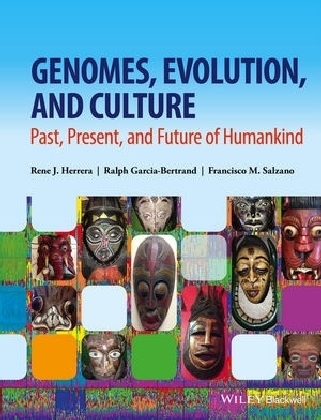
Genomes, Evolution, and Culture
Wiley-Blackwell (Verlag)
978-1-118-87640-4 (ISBN)
Rene Herrera Emeritus, Department of Molecular and Human Genetics, College of Medicine, Florida International University, USA Ralph Bertrand Department of Biology, Colorado College, USA Francisco Salzano Departamento de Genética, Instituto de Biociências, Universidade Federal do Rio Grande do Sul, Brazil
Preface, ix
1 The history of human evolutionary genetics, 1
World views, 1
Science and philosophy, 1
The biology of mankind: anatomy and physiology in a historical context (up to the 16th century), 3
Beginnings of the present scientific model, 4
Biological evolution and genetic foundations: the brilliant quartet, 5
Nineteenth century: cytology, embryology, and reproduction, 9
Twentieth century, the century of genetics, 10
The synthetic theory of evolution, 11
Bacterial and molecular genetics, 11
Parallel developments: paleoanthropology, 12
Technical and methodological developments, 13
Conclusions, 14
Review questions and exercises, 14
References, 14
2 The human genome: structure, function, and variation, 16
Science, politics, and ethics, 16
Structural aspects, 17
Normal and abnormal phenotype distribution, 19
Function, 21
Sex chromosomes, 23
Paleogenomics, 25
Variability: mtDNA, 28
Nuclear variability, 28
Exomes and proteomes, 30
Selection or drift? History, 31
Selection or drift? Methods, 32
Selection or drift? Analyses, 34
Nervous system and culture, 37
Conclusions, 37
Review questions and exercises, 37
References, 38
3 Population structure, 42
DNA-based marker systems, 42
SNPs, STRs, and Indels as DNA markers, 45
Population genetic tools for analyzing population structure, 49
Forces affecting population dynamics, structure, and evolution, 55
Applications of population genetics, 60
From populations to races and species, 62
Review questions and exercises, 64
References, 65
4 Genetic variability, 68
On the nature of variability, 68
Mechanisms responsible for generating genetic variability, 69
Randomness of mutations, 71
Inheritance and environment, 75
Selection works on the phenotype, 76
The impact of selection, 77
Cultural expressions as markers of ancestry, 79
Congruency among marker systems, 80
Does junk DNA exist?, 80
How genetic diversity is studied?, 82
Epigenetic diversity, 84
Review questions and exercises, 85
References, 86
5 Gene and genomic dynamics, 87
Molecular evidence for punctuated equilibrium and gradualism, 88
Next-generation sequencing, 90
Genetic variation, 92
Variation, population structure, and effective population size, 94
Recombination and its effect on variation, 94
Linkage equilibrium and disequilibrium, 95
Forces leading to linkage disequilibrium, 98
Linkage disequilibrium and SNP haplotypes, 99
Linkage disequilibrium in humans, 100
Genome structural variations, 102
CNV classifications and formation mechanisms, 102
Methods used to detect CNVs, 103
CNVs associated with human phenotypes, 105
CNVs and evolution, 106
CNV in primates, 107
Chromosome rearrangements and selfish genetic elements, 108
Transposable elements, 109
Population dynamics of transposable elements, 110
Transposons in human evolution, 111
Selfish genetic elements in evolution, 113
Genome-wide association studies, 113
Concerns over the effective use of GWAS, 117
Conclusions, 117
Review questions and exercises, 118
References, 119
6 Human origins and early diasporas, 124
The on switch to humanity, 124
Early hominins, 128
Emerging themes and variations in hominin evolution, 130
The first hominin migrants, 134
The emergence of modern humans, 135
The Saharan pump, 135
Early migrations, 136
Neanderthals prevailed, 136
Review questions and exercises, 138
References, 139
7 Culture, 141
Concept, 141
Origin and development, 141
Factors that could condition cultural evolution, 142
Biology–culture interaction, 145
Language, 146
Domestication, 148
Art, 151
Free will, morality, and religion, 153
Conclusions, 155
Review questions and exercises, 155
References, 155
8 Health and disease, 158
Hopes and reality, 158
Concept of health and methods of study, 158
Darwinian medicine, 160
Parent–offspring conflict, 161
Pathogen history, 161
Evolution of infectious diseases, 162
DNA damage, mutagenesis, and teratogenesis, 163
What is better, more or less gene product?, 165
Genetic manipulation of animals to study health and disease, 166
Reproductive fitness and health, 167
Consanguinity, 168
Violence, 168
Cancer, 171
Degenerative diseases, 172
Ecogenetics, pharmacogenetics, and pharmacogenomics, 174
Detection of genetic diseases, 176
Genetic counseling, 176
Treatment, 178
Conclusions, 179
Review questions and exercises, 179
References, 180
9 Recent human evolution: an integrative approach, 182
Recent human evolution, 182
Out of Africa, 184
Back to Africa, 188
Beyond Arabia, 190
The Asian agricultural revolution and the Austronesian expansion, 194
Evidence from plants and animals, 198
Contacts between South America and Polynesia, 200
Review questions and exercises, 202
References, 203
10 Bioethics: consequences and implications of genetic technology on human evolution, 206
Social and biological evolution, 207
Overview of ethics and philosophical influences on Western ethics, 207
Evolution of ethics and morality, 212
The history and beginning of modern-day bioethics, 213
Reproductive technologies and the new eugenics: unnatural selection?, 216
Enhancement through IVF, PGD, and CRISPR, 219
Ethical issues associated with medical technology, 220
Gene therapy, 220
Stem cell therapy, 222
Biosimilars, 222
Genetic privacy, 222
Genetic testing, 223
DNA profiling, 224
Conclusions, 227
Review questions and exercises, 227
References, 228
11 Future of human evolution, 230
Gene and culture coevolution, 231
Life expectancy and population growth: past, present, and future, 231
Mutation rates and future evolution, 232
The evolution of new genes, 234
Climate change, 234
Diet, 235
Sex selection, 236
Artificial selection, 236
Transhumanism and artificial intelligence, 237
Conclusions, 238
Review questions and exercises, 239
References, 239
Appendix, 241
Index, 249
| Erscheinungsdatum | 10.05.2016 |
|---|---|
| Verlagsort | Hoboken |
| Sprache | englisch |
| Maße | 193 x 249 mm |
| Gewicht | 726 g |
| Themenwelt | Naturwissenschaften ► Biologie ► Humanbiologie |
| Sozialwissenschaften ► Soziologie | |
| ISBN-10 | 1-118-87640-7 / 1118876407 |
| ISBN-13 | 978-1-118-87640-4 / 9781118876404 |
| Zustand | Neuware |
| Informationen gemäß Produktsicherheitsverordnung (GPSR) | |
| Haben Sie eine Frage zum Produkt? |
aus dem Bereich


